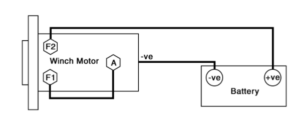A winch is a powerful tool, and you need to follow the right steps to make sure your winch is wired safely. Normally, you need a solenoid to wire a winch, but you can do it also without the solenoid in place. This post will help you know how to wire a winch without a solenoid and give you detailed guidelines.
To wire a winch without a solenoid, you need some essential tools with the right procedure to do it. The essential tools are a spanner or pliers, a winch solenoid diagram, and a jumper cable. Once you have the tools, you can go on to wire your winch following the method we’re about to discuss below.
What Is a Solenoid Use in A Winch, And What Does it Do?
A winch solenoid is a key component to bringing the entire winch system to life. The job of a solenoid is to act as a switch that completes the electrical circuit of your winch and allows it to function.

This part of the winch is needed to control the positive and negative flow of electrical current from the battery to your winch motor. The solenoid controls the direction of your winch, and it also controls how fast it can operate in each direction.
In addition, the solenoid does the work of a mechanical switch. As the driver or an assistant (like a family member or friend) operates the winch remote control, the solenoid inside the remote-control box uses electromagnetism to actuate and connect an electrical circuit. This tells the motor in your winch to roll your cable in and out, which is how your winch works.
When do You need to Wire a Winch Without A Solenoid?
If your winch fails or loops, it could mean a disaster for your vehicle. That is why you need to wire a winch without a solenoid. All car trailer winches use electrical power, usually in the form of a battery. They transfer that power to the motor through wires inside the winch.

Those wires can wear down or develop shorts after repeated use; the motor won’t work correctly when that happens. This article will talk about how and why you might need to replace those wires yourself.
Also, it is safe to wire a winch without a solenoid because it can effectively protect users from electrical hazards. A winch without a solenoid is safe and more reliable than other companions that use wired connections.
In addition, you could bypass the solenoid. However, it only becomes necessary when the solenoid is broken or worn out. Wire your winch without a solenoid using the included wiring kit. They have all you need to complete the job. You can keep your favorite winch for your trucks or Jeeps and save money by keeping it in service.
What Is The Easiest Method To Wire A Winch Without A Solenoid?
If you want to wire a winch without a solenoid, then you can try doing it using this method.
Begin by Analyzing the Solenoid Diagram
The first step to wiring a winch without a solenoid is to take your time to observe or study the diagram. You need to have the right understanding of how it works. Using a diagram blueprint will make it easier for you.
You must use a solenoid diagram because it will help in the process of installation or using the device. You can always get a diagram from the manufacturer or seek the counsel of any mechanic around you.

Set the Winch in The Free Spool Stage
It simply means that you have to put your car in neutral gear. You must do this, and you can only achieve this by reaching out to the knob that makes the system easy to move and then turning it. Note that the winch is not loaded to avoid any accident before you turn the knob.
Disconnect the Terminal
The next step is to disengage the terminal right from the battery. While you have the grounded lead engaged, you need to start decoupling the battery from the positive lead. Again, you must label the cables, especially if you are doing this for the first time.
It will help you avoid any mix-ups or mistakes while using the winch.
Link Your Jumper Cable
The next step is to connect the jumper cable. First, you should run the cable from A to point F1. After that, you need to connect with the battery through the F2. This connection should make the winch run in one direction if you did the right thing.
Repeat With Another Post
You can then repeat the same process with A and F2 posts. You need to use the F1 to connect them to the power source. Once you are done with this, the winch should be able to run in the opposite direction.
You now repeat the procedure with the A and F2 posts and connect it to the power source using the F1 post. On completing the connection, the motor will run on the opposite side.
Safety Precautions That You Should Follow While Wiring Winch Without Solenoid
Now that you know the wiring diagram for the winch solenoid let’s look at tips to wire your winch solenoid. You must keep in mind some safety rules while wiring your winch solenoid as mentioned below:
- Always keep your hands away from the drum when there is no load on it
- You should never stand or sit on top of pointy and free objects while winching
- Do not stand near the winch while winching in or out
- If vehicles are being winched, then place them on stable surfaces
- Prepare yourself as you may fall at any time
- Protect yourself from shock
- Winches must be used carefully as improper usage can lead to fatal injuries.
- When connecting a winch to a motor vehicle, you need to ensure that the equipment is properly installed
- Ensure that the starter battery has enough power to activate the winch before you start lifting the load with the cable
Conclusion
While wiring a winch with proper lead is utterly important, giving it the necessary setup is equally crucial. Although the solenoid is a major part of the winch, now you know how to wire a winch without a solenoid just fine.
Follow the guide above and wire the winch properly. Before you go for a real job with the winch, make sure you’ve tested it out with no load on the motor. After that, you can go on with it as usual. And lastly, don’t forget to practice the safety tips to keep yourself and your winch in one piece, up and running neat.
Recent Posts
It’s relatively easier when you’re buying a brand-new winch as you can choose one with cable or rope pre-installed. But when you’re planning on replacing the current cable winch, you will...
Getting your winch cable snapped in the middle of nowhere is not an uncommon thing. If you’re not ready for such situations in prior, you won’t have an escape from there. So, knowing a few...
